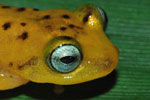The misty mountains of the Western Ghats seem to unravel new secrets the more you explore it. Researchers have discovered two new frog genera, possibly restricted to rare and threatened freshwater swamps in the southern Western Ghats of India. The discoveries, described in the open-access journal Zootaxa, prove once again the importance of the mountain range as a biodiversity hotspot.
The Western Ghats is home to a stunning variety of flora and fauna ranging from large mammals like the Asiatic elephant (Elephas maximus) to fascinating amphibians such as the Malabar gliding frog (Rhacophorus malabaricus). Tree frogs like these gliding frogs belong to quite a diverse family of amphibians: Rhacophoridae. The mostly-arboreal rhacophorids are found in habitats including ground litter, on bushes and tree tops. Their reproductive modes also vary greatly: some lay eggs in foam nests that develop into tadpoles and metamorphize into frogs while others develop directly from eggs into young frogs. Around 60 rhacophorids are found in the Western Ghats. But knowledge about amphibian diversity in the mountain range has surged, with over 70 new species across all known genera discovered over the past decade.
  Top: the new genus: Beddomixalus . Bottom: the new genus: Mercurana. Photos by: Ansil B. R. |
A team led by independent researchers Robin Kurian Abraham and Anil Zachariah have added to this list, with their find of two new rhacophorid genera in the southern Western Ghats. Their study describes the new genera, Beddomixalus and Mercurana, based on morphological, anatomical, behavioral and genetic differences. Apart from observing mating and reproductive behaviour, they also studied the life history stages of tadpoles. To confirm the new species, the scientists collected tissue samples from frogs and tadpoles, and deposited them in a museum repository. The robust genetic information gleaned from the tissue samples compared with 183 other rhacophorids confirmed that the two collected species were different enough to warrant classification into new genera.
Yet, could they actually see the difference? It was during their initial field surveys that Abraham and his team realized that the frog they were observing could potentially be a new species, and in fact, a new genus. Other similar-looking rhacophorids in the Western Ghats are mostly foam-nesters.
“But this frog buried the eggs in the swamp floor, with the female actually digging a small pit and mixing the eggs with mud and leaf litter. This was intriguing,” says Abraham.
They named this genus Mercurana, after the late iconic lead singer Freddie Mercury of the British rock band Queen. Of Indian origin, Mercury spent the bulk of his childhood in Panchgani, in the northern part of the Western Ghats. The new species is named Mercurana myristicapalustris, being restricted to low-elevation marshes called Myristica swamps (named after the several species of Myristica or wild nutmeg trees that grow here).
The team had simultaneously been studying another species, previously classified into a genus of foam-nesters, Polypedates. Yet, to their surprise, the frogs they observed did not build foam nests; they laid their eggs exposed, on the swamp-bed. Realizing these frogs were also very different and with strong genetic data to back them up, Abraham and his colleagues have changed the genus of this species. They named the new genus Beddomixalus, in honor of Colonel Richard Henry Beddome, a pioneer in the study of amphibian diversity in the Western Ghats during the British era. The species, now Beddomixalus bijui, is restricted to the mid and high-elevation swamps of the southern Western Ghats.
These Myristica swamps, though home to specialists such as these frogs, are one of the most fragmented and threatened ecosystems in the mountain range, says Abraham. Many swamps have been converted to paddy fields, oil palm and rubber plantations. In addition, with climate change looming large, the researchers hope to focus on understanding the effects of climatic shifts on these genera in future studies.

Tadpole of Beddomixalus bijui. Photo by: Anil Zachariah.

The lowland Myristica-swamp ecosystem, which remains water-logged for most of the year. Photo by: Robin Kurian Abraham.

The southern Western Ghats, home to Beddomixalus and Mercurana. Photo by: Anil Zachariah.
CITATION: Robin Kurian Abraham, R. Alexander Pyron, Ansil B. R., Arun Zachariah & Anil Zachariah (2013). Two novel genera and one new species of treefrog (Anura: Rhacophoridae) highlight cryptic diversity in the Western Ghats of India. Zootaxa 3640 (2): 177-189.
Related articles
Looking beyond the hundred legs: finding new centipedes in India requires many tools

(04/08/2013) A small, boneless creature, that lives underground, with a “hundred” legs, and a rather powerful sting; some of these creatures are drab, but some are so beautiful and brightly colored that they can startle. Centipedes. There is more to a centipede than its many legs, and its habit of darting out of dark places. One of the first lifeforms to turn up on land, some centipede fossils date back to about 450 million years ago. They have been evolving steadily since, with some estimates showing about 8,000 species today. Not even half of these species have been taxonomically described.
Photographers threatening the already-abused slender loris
-Arun-Kanagavel.150.jpg)
(03/12/2013) Caught in a beam of torchlight, the eyes of the slender loris reflect back a striking glow. In an effort to better understand these shy, nocturnal primates, a team of researchers set out to the Western Ghats of India. The resulting paper: Moolah, Misfortune or Spinsterhood? The Plight of the Slender Loris (Loris lydekkerianus) in Southern India was published in the Journal of Threatened Taxa in January of 2013. Forest walks and interviews with the Kani people, who live in close proximity to the lorises, supported evidence of a surprising new threat to the lorises: photographers.
Gaining from rain: precipitation is an indicator of tropical forest biodiversity
(11/12/2012) Policymakers seeking to conserve forests in southern India should focus on those receiving the highest levels of rainfall, according to new research. Scientists from the Center for International Forestry Research (CIFOR) found rainfall to be the most important environmental determinant of species richness in the Anamalai region of the southern Western Ghats.
Livelihoods depend on the environment in the Western Ghats
(09/27/2012) In the Uttar Kannada district of the Western Ghats, the livelihood of the average individual depends largely on the well being of the environment. Six months ago, before large-scale mangrove planting of the area, if someone were to walk through the banks of the mangroves in the Western Ghats he would see many fishermen casting their long nets and wires, time and time again noticing pieces of trash such as plastic grocery bags tangled in the nets.
Recommendations to save India’s Western Ghats creates political stir

(08/20/2012) A massive expert panel report on the conservation of the Western Ghats has caused a political stir in India. The report, headed by noted ecologist Madhav Gadgil, recommends that the government phase out mining projects, cancel damaging hydroelectric projects, and move toward organic agriculture in ecologically-sensitive sections of the Ghats. The report, which was leaked after the government refused to release it, has yet to be implemented. Recently dubbed a UNESCO World Heritage Site, the Western Ghats is one of India’s largest wildernesses and home to thousands of species, many found no-where else.
Poaching results in elephant gender imbalance in Indian park
(07/09/2012) Scientists have undertaken a new census of Asian elephants (Elephas maximus) in India’s Biligiri Rangaswamy Temple Tiger Reserve (BRT) following almost 30 years of sustained poaching. Estimating that the park contains four female elephants for every male, the scientists warn in a new study in mongabay.com’s open access journal Tropical Conservation Science that this gender imbalance threatens the population. Poachers target male Asian elephants for their tusks, generally leaving females untouched.
India’s Western Ghats rainforest declared UNESCO World Heritage Site
(07/03/2012) India’s Western Ghats, considered one of the richest biodiversity hotspots in the world, has been dubbed a UNESCO World Heritage Site. In total, 39 different sites in the tropical rainforest—home to Asian elephants, Bengal tigers, lion-tailed macaques, and thousands of other species—have made it under the listing.
Photos: 10 new frogs discovered in India’s great rainforest

(08/09/2011) Ten new species of frog have been discovered in India’s Western Ghats according to two new papers in Biosystematica. Although human populations have farmed in the Western Ghats for centuries, the new discoveries prove that the rainforest still holds many surprises. The Western Ghats lie along India’s west coast and have been dubbed one of the world’s biodiversity hotspots, but the rich wildlife is imperiled by rising human impacts.
Balancing agriculture and rainforest biodiversity in India’s Western Ghats

(08/08/2011) When one thinks of the world’s great rainforests the Amazon, Congo, and the tropical forests of Southeast Asia and Indonesia usually come to mind. Rarely does India—home to over a billion people—make an appearance. But along India’s west coast lies one of the world’s great tropical forests and biodiversity hotspots, the Western Ghats. However it’s not just the explosion of life one finds in the Western Ghats that make it notable, it’s also the forest’s long—and ongoing—relationship to humans, lots of humans. Unlike many of the world’s other great rainforests, the Western Ghats has long been a region of agriculture. This is one place in the world where elephants walk through tea fields and tigers migrate across betel nut plantations. While wildlife has survived alongside humans for centuries in the region, continuing development, population growth and intensification of agriculture are putting increased pressure on this always-precarious relationship. In a recent paper in Biological Conservation, four researchers examine how well agricultural landscapes support biodiversity conservation in one of India’s most species-rich landscapes.